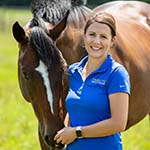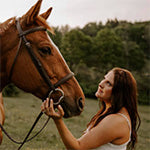After a foal is weaned, it’s vital they receive enough nutrients to support the way their bodies are rapidly growing. However, because weanlings and yearlings do grow so rapidly, it can be hard to know what and how much to feed them throughout this part of their young life.
Each horse grows at their own individual rate, while some young horses begin to slow down their rate of growth as early as 6 months of age, many maintain in a phase of rapid growth into their yearling year.
This is why it’s important to feed growing horses based on their physiological growth rate, and not necessarily by their chronological age.
In this article, you’ll gain a better understanding of what to feed, how much to feed, when to make diet changes for your weanlings and yearlings, and growth rate information for optimum health during this stage of life.
What To Feed Weanling and Yearling Horses
Feeding weanlings and yearling horses can be challenging because of how their bodies are constantly changing and growing—meaning their diet should change and grow with them.
Weanling diets should never be less than 30% forage based on their weight, and ideally, they should have much more forage than this minimum. Maximizing forage intake mimics their natural feeding behavior, and it’s also ideal for proper gut health. Because their hindgut is still developing, young horses are not equipped to handle “stemmy” forage. Good pasture or a soft hay should be supplied.
A “ground up” nutrition strategy is the best approach for feeding horse feed to these growing weanlings and yearlings. This strategy starts by meeting the growing horses’ non-calorie nutrient requirements, including amino acids, minerals, and vitamins. Then, you’ll add in a calorie source as needed to maintain the ideal desired body condition score. They should ideally stay in a moderate body condition, with a body score of about 5 – 6. You can learn more about horse body condition scoring here.
This is typically accomplished by feeding a ration balancer, like Essential K®, for the easy keepers or a full intake growth feed, like Growth, for weanlings and yearlings that need additional calories to maintain their body condition.
While feeding a high quality ration balancer or growth feed designed for the type of forage you are supplying may be slightly more expensive than feeding an “all stages” type feed, it can save in veterinary costs or lost sales value later due to Developmental Orthopedic Disorders (D.O.D.) or other conditions caused by poor nutrition during growth.
Developmental Orthopedic Disorders
Developmental Orthopedic Disorders are a group of abnormal growth conditions in young foals, including physitis and Osteochondrosis Dessicans (OCD). Poor nutrition is one of several factors in the development of these issues during growth.
According to current research, diets that are excessively high in calories, especially calories from non-structural carbohydrates (NSC), are a main contributor to D.O.D. If the ratio of calories to other critical nutrients in the diet is out of balance or deficient, this can also cause D.O.D. Foals between the ages of 3 and 9 months of age are at greatest risk of D.O.D.
The requirements for crude protein, lysine, calcium and phosphorus increase quickly in these growing horses’ bodies—even more so than their energy requirements. When fed copper levels that are 3-4 times higher and zinc levels 2-3 times higher than the current Nutrient Requirements of Horses (NRC, 2007) recommendation, there is evidence that this may help alleviate the incidence of D.O.D. This is true in many situations, but especially in programs with faster-growing horses.
This is why it’s believed low copper and zinc levels are a major contributor to D.O.D. Ensuring proper levels of zinc and copper are fed during the first trimester of the broodmare’s pregnancy and continually fed to the foal until he has ceased growing is vital.
How Much to Feed Weanlings and Yearlings
Monitoring the growth rate of these weanlings and yearlings frequently is important for calculating how much, and what, to feed.
When choosing a feed for your weanling or yearling, the horse feed portion of their diet should complement the type of forage they receive, such as hay or pasture grass. Particular attention should be given to the calcium and phosphorus ratios, as well.
The ideal calcium to phosphorous ratio in the total diet of growing horses is between 1:1 and 2:1. Growing horses consuming forage sources composed of 50% or greater alfalfa or other legumes should be fed a feed specifically designed to balance the nutrient profile of these legumes, such as Alfa Growth®.
Young and growing horses require a specially designed feed diet to meet their unique needs. With many poorly designed feeds, horses may have to be fed more to meet the requirements of non-calorie nutrients. Unfortunately, this can cause the development of excess body fat, which can aggravate D.O.D.
Try to keep weanlings and yearling horses in moderate body condition, with a body score of 5-6, to avoid this. You can monitor body weight with a scale or weight tape every 2-4 weeks to ensure you make more accurate adjustments based on their unique growth rate. Then, you can increase or decrease their feed or add in things like ration balancers or fat supplements as needed.
For calculating weight with a tape, measure:
-
Around your horse's heart girth
-
The length from the point of shoulder to point of buttock
Plug these measurements into the bodyweight equation below to estimate your horse’s weight.
Weanlings: [heart girth (in)2 × length (in)] ÷ 280 = weight (lb)
Yearlings: [heart girth (in)2 × length (in)] ÷ 301 = weight (lb)
Optimal Growth Versus Maximum Growth Rates
When tracking how quickly your weanling or yearling is growing and gaining weight, you might be wondering if they are growing at a proper rate.
Ideally, you should be feeding your weanlings and yearlings in a way that encourages a moderate and steady growth rate. The recommended average daily weight gain for weanlings and yearlings ranges from 0.28 to 0.39 percent of the horse’s body weight, respectively.
Feeding a weanling or yearling horse for a maximum growth rate is not desirable, however. This is because bone hardening, as they grow, lags significantly behind bone lengthening as they grow. By the time a young horse is a year old, they could reach up to 95% of their mature height. However, only about 75% of the horse’s mature bone mineral content is reached by this age.
This is why, ideally, growing horses should gain weight at a rate that is optimal for developing bones, so they have the strength to support the weight and bone length they are gaining.
Overfeeding and rapid weight gain should be avoided for this reason, as well. Rapid weight gain can increase the risk of D.O.D, along with other unsoundness or skeletal anomalies. Uneven growth rates can also cause these problems, so quickly switching an underfed, growing foal to a good diet that allows for quick growth can also increase these risks.
Feed Options from Tribute® for Weanlings and Yearlings
Ensuring the weanling or yearling’s diet of forage and horse feed combined is balanced is vital for their growing bodies.
The most common nutrients that are unbalanced or deficient in weanlings or yearlings are essential amino acids (starting with lysine), calcium to phosphorous ratios (especially if using legumes), and copper and zinc levels.
Tribute® Growth Pellet is balanced and specifically formulated for growing weanlings and yearlings who are consuming grass hay variety forages. Growth Pellets can be fed to growing horses starting at 3 months of age and can also be fed to pregnant and lactating broodmares.
Even mares and foals with metabolic disorders or Developmental Orthopedic Disorder can be given Growth Pellet because of its premium essential nutrient profile, low levels of sugar and starch (NSC), and higher levels of fat and fiber. For an extra boost of essential nutrients or for horses needing a lower calorie diet, Essential K® is a pelleted, low NSC ration balancer designed for horses eating grass-based forages.
If the hay or pasture being fed to your weanling or yearling is greater than 50% legumes or alfalfa, Alfa Growth® might be a better fit. Alfa Growth® is a higher fat, textured horse feed that is still appropriate for pregnant mares, lactating mares, and growing horses that are consuming mostly alfalfa or clover hays. For an added ration balancer or for easier-keeping growing horses, Alfa Essentials® is also formulated for horses consuming mostly clover hay or alfalfa.
Since weanlings and yearlings are growing so rapidly, it can be hard to know exactly what and how much to feed them as their bodies, and body condition score, can constantly change. If you'd like help with a personalized feeding plan for your young horse to know exactly what and how much you should be feeding them through each stage of life, our team would love to help!
Sources
Wilson, K.R., S. Jackson, C. Abney, B.D. Scott and P.G. Gibbs. 2005. Body weight estimation methods as influenced by condition score, balance score and exercise in horses. In Proceedings, 19th Equine Science Society. Page 57 - 62.


